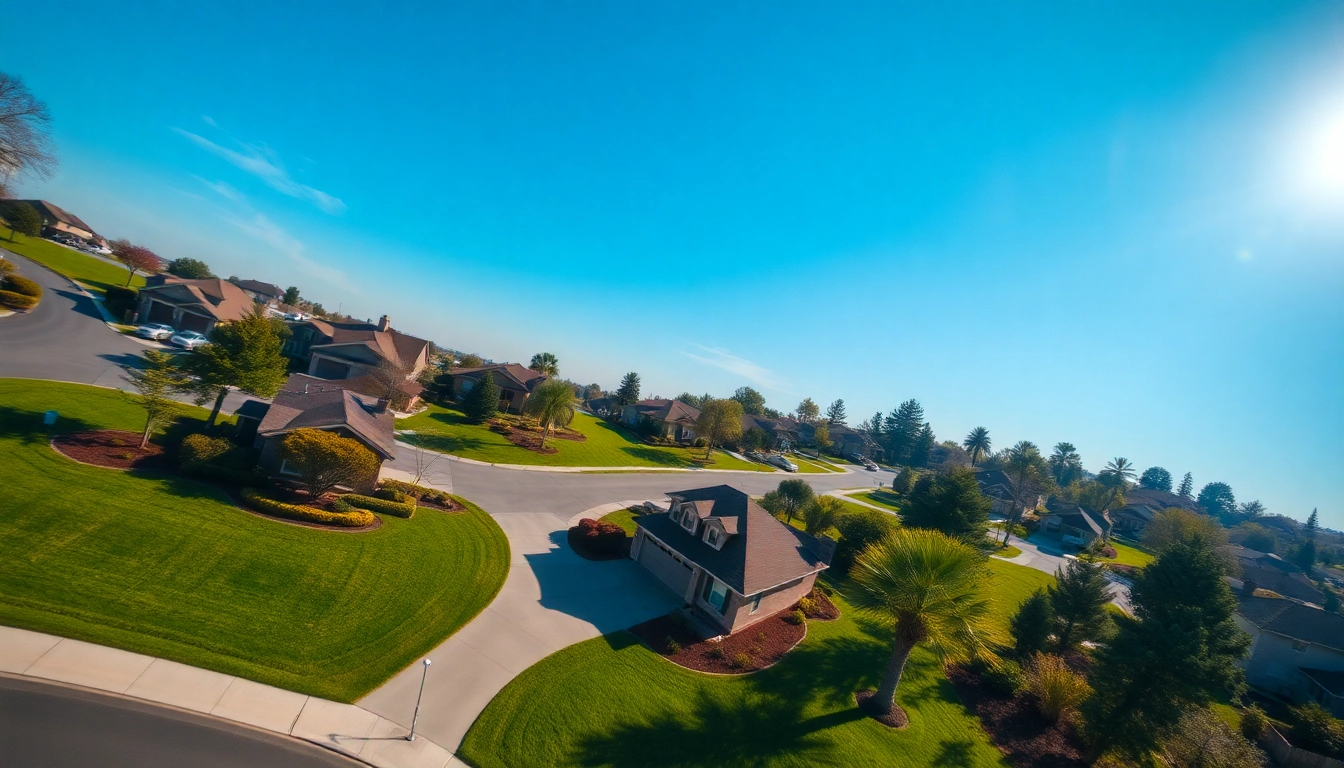Understanding Real Estate Aerial Photography
Definition and Importance
Real estate aerial photography involves capturing high-quality images of properties from elevated perspectives, typically utilizing drones or aircraft. This innovative visual technique has transformed the way properties are marketed, providing potential buyers with an immersive view of the listings. By showcasing the intricate details of a property and its surrounding environment, aerial photography plays a crucial role in enhancing the overall appeal and marketability of real estate. Incorporating real estate aerial photography into marketing campaigns not only improves listing visuals but also helps real estate agents stand out in a competitive market.
Types of Aerial Photography Techniques
Aerial photography techniques vary widely, each offering unique benefits for real estate marketing. The most common types include:
- Drone Photography: Utilizing drones equipped with high-resolution cameras, this technique allows for detailed and flexible aerial shots. Drones can capture a variety of angles and altitudes, giving marketers scope to present properties dynamically.
- Helicopter Photography: Ideal for larger properties or panoramic shots, helicopters can cover more area and provide a completely different perspective compared to drones. This method often results in stunning imagery ideal for luxury listings.
- Fixed-wing Aircraft Photography: Similar to helicopter photography, this method employs fixed-wing aircraft and is particularly useful for covering expansive terrains and capturing wide landscapes seamlessly.
Applications in Real Estate Marketing
The applications of aerial photography are vast, enhancing various aspects of real estate marketing. By employing aerial techniques, real estate professionals can:
- Showcase entire property plots along with gardens, pools, and nearby amenities.
- Illustrate neighborhood features, such as proximity to parks, schools, and shopping areas.
- Create visually compelling narratives that guide potential buyers through the property and its features.
Benefits of Real Estate Aerial Photography
Captivating Visuals that Attract Buyers
Compelling imagery is crucial in catching the eye of prospective buyers, and aerial photography provides captivating visuals. High-quality aerial photographs create an engaging first impression and can increase interest in a property significantly. In a market saturated with listings, such striking images can make a significant difference in how properties are perceived. Buyers are often more inclined to explore properties that present stunning visuals and creative angles that highlight the property’s unique features.
Showcasing Property Features and Surroundings
Aerial photography goes beyond mere images of homes. It expertly showcases unique features and surroundings that might be overlooked from ground level. Properties with expansive yards, intricate landscaping, or those situated in scenic locations can be depicted beautifully, highlighting aspects such as:
- Spatial relationship between the home and nearby amenities like parks, schools, and commercial hubs.
- The layout of multi-family properties or large estates that require a comprehensive overview.
- Natural features such as bodies of water, gardens, and views, enhancing the property’s appeal.
Boosting Engagement on Listings
Listings equipped with aerial photographs tend to receive higher engagement rates compared to those with standard images. This strategic inclusion can lead to:
- A reduction in listing time as properties that stand out are more readily considered by buyers.
- A higher likelihood of sharing on social media, enhancing organic reach and visibility.
- Elevated opportunities for potential buyers to understand the property’s context and potential.
How to Choose an Aerial Photographer
Evaluating Skills and Experience
Selecting the right aerial photographer is imperative for success in real estate marketing. Potential clients should evaluate candidates based on their skills and prior experience:
- Portfolio Review: Reviewing a photographer’s portfolio provides insight into their style and proficiency. Look for diversity in completed projects and ensure it aligns with the aesthetic you desire.
- Industry Experience: Ideal candidates will have a robust background in real estate photography specifically. Experienced photographers understand the nuances necessary to capture compelling property images.
Understanding Equipment and Techniques
The quality of the equipment directly impacts the final output of aerial photography. Knowledge about the types of drones or cameras used, along with their capabilities, is critical when choosing a photographer. Consider the following:
- Camera Resolution: Higher resolutions yield sharper images, crucial for showcasing property details.
- Stabilization Equipment: Effective stabilization ensures clear images, especially in windy conditions or during fast movements.
Reviewing Past Work and Client Testimonials
Gathering feedback from previous clients can unveil key insights into a photographer’s reliability and professionalism. Positive testimonials and reviews are indicative of customer satisfaction and can help ascertain a photographer’s ability to deliver high-quality results consistently. Reach out to past clients if possible, and inquire about:
- Timeliness: Did the photographer deliver images on schedule?
- Professionalism: What was the communication experience like?
- Final Output: Did the delivered images meet the clients’ expectations?
Best Practices for Using Aerial Photography in Listings
Creating Compelling Visual Narratives
Successful real estate marketing requires more than just showcasing images; crafting a compelling visual narrative is essential. Here are effective ways to create narratives:
- Storytelling Elements: Incorporate elements of storytelling by providing information about the property’s history, the lifestyle it offers, or nearby locations that make it attractive.
- Integrated Visuals: Combine aerial shots with interior images, creating a holistic view of the property experience.
- Emotionally Engaging Captions: Pair photographs with captions that evoke emotions, helping potential buyers visualize themselves in the space.
Optimizing Photos for Online Platforms
High-quality photos are only effective if they are optimized for the platforms where they will be shared. Remember these tips:
- Image Size and Format: Ensure that pictures are in formats suitable for various real estate listing sites and maintain high resolution while optimizing for fast loading.
- SEO Optimization: Use descriptive filenames and alt-text descriptions, helping the images rank higher in search engines and making real estate listings more discoverable.
- Device Responsiveness: Make certain that the images look great on all devices, as many buyers search on mobile devices.
Integrating with Other Marketing Strategies
Maximizing the impact of aerial photography involves integrating it with other marketing strategies. Opportunities include:
- Social Media Promotions: Utilize aerial photos in social media ads and posts to capture attention and drive traffic to listings.
- Email Marketing: Incorporate aerial shots into newsletters or targeted emails for an engaging visual experience.
Virtual Tours: Combine aerial photography with virtual tour capabilities, offering potential buyers an engaging and interactive way to experience the property.
Measuring the Impact of Aerial Photography
Tracking Engagement and Conversion Rates
Evaluating the effectiveness of aerial photography requires the assessment of engagement and conversion metrics. Use analytic tools to track:
- Click-through Rates (CTR): Monitor how often listings featuring aerial photography lead to inquiries or viewings.
- Social Shares: Gauge how often visuals are shared across platforms, which can indicate popularity and engagement.
- Inquiry Rates: Analyze how many potential buyers reach out based on aerial photography included in a listing.
Collecting Feedback from Potential Buyers
Direct feedback from potential buyers can provide invaluable insights into the perceived value of aerial photography in property marketing. Consider utilizing:
- Post-Viewing Surveys: Gather impressions on how aerial shots influenced their perception of the property.
- Selective Focus Groups: Conduct discussions with engaged buyers about visual marketing strategies and what resonates most with them.
- Simplified Feedback Forms: Quick forms after online viewings can help in understanding the immediate impact of visuals.
Adapting Strategies Based on Performance Data
Continuously improving marketing strategies through data-informed decisions is crucial. Analyze performance data regularly and adjust tactics accordingly:
- Experiment with different aerial perspectives to find the most compelling angles.
- Modify marketing messages around the imagery based on buyer feedback and engagement metrics.
- Stay informed about emerging trends in real estate marketing to keep your strategies fresh and relevant.



